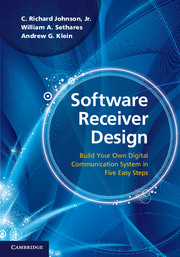Book contents
- Frontmatter
- To the Instructor …
- Contents
- Dedication
- Step 1 The Big Picture
- Step 2 The Basic Components
- Step 3 The Idealized System
- Step 4 The Adaptive Components
- Step 5 Putting It All Together
- Appendices
- A Transforms, Identities, and Formulas
- B Simulating Noise
- C Envelope of a Bandpass Signal
- D Relating the Fourier Transform to the DFT
- E Power Spectral Density
- F The Ƶ-Transform
- G Averages and Averaging
- H The B3IG Transmitter
- Index
C - Envelope of a Bandpass Signal
from Appendices
Published online by Cambridge University Press: 05 June 2012
- Frontmatter
- To the Instructor …
- Contents
- Dedication
- Step 1 The Big Picture
- Step 2 The Basic Components
- Step 3 The Idealized System
- Step 4 The Adaptive Components
- Step 5 Putting It All Together
- Appendices
- A Transforms, Identities, and Formulas
- B Simulating Noise
- C Envelope of a Bandpass Signal
- D Relating the Fourier Transform to the DFT
- E Power Spectral Density
- F The Ƶ-Transform
- G Averages and Averaging
- H The B3IG Transmitter
- Index
Summary
The envelope of a signal is a curve that smoothly encloses the signal, as shown in Figure C.1. An envelope detector is a circuit (or computer program) that outputs the envelope when the signal is applied at its input.
In early analog radios, envelope detectors were used to help recover the message from the modulated carrier, as discussed in Section 5.1. One simple design includes a diode, capacitor, and resistor arranged as in Figure C.2. The oscillating signal arrives from an antenna. When the voltage is positive, current passes through the diode, and charges the capacitor. When the voltage is negative, the diode blocks the current, and the capacitor discharges through the resistor. The time constants are chosen so that the charging of the capacitor is quick (so that the output follows the upward motion of the signal), but the discharging is relatively slow (so that the output decays slowly from its peak value). Typical output of such a circuit is shown by the jagged line in Figure C.1, a reasonable approximation to the actual envelope.
It is easy to approximate the action of an envelope detector. The essence of the method is to apply a static nonlinearity (analogous to the diode in the circuit) followed by a lowpass filter (the capacitor and resistor).
Information
- Type
- Chapter
- Information
- Software Receiver DesignBuild your Own Digital Communication System in Five Easy Steps, pp. 416 - 420Publisher: Cambridge University PressPrint publication year: 2011
